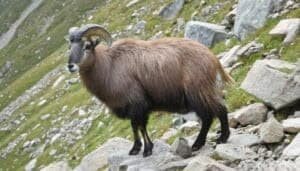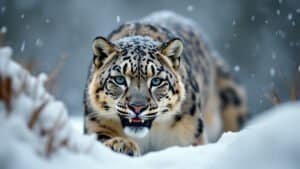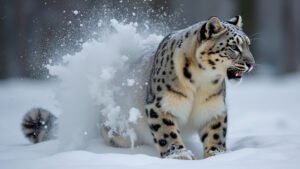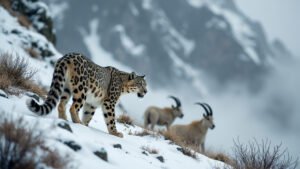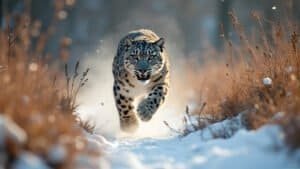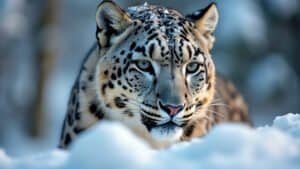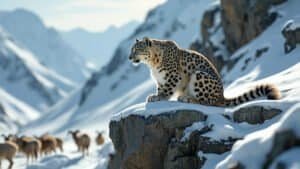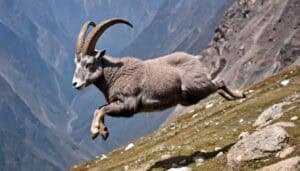Introduction
Snow leopards, majestic and elusive big cats, are native to the mountainous regions of Central and South Asia. Understanding their primary diet is essential to grasp how they survive in such harsh environments
This article explores the common prey of snow leopards, their unique hunting strategies, and the role of the rugged terrain and seasonal changes in their feeding habits
We’ll also look into their secondary and opportunistic prey, dietary needs, and how these factors influence snow leopard populations
Common Prey of Snow Leopards
Snow leopards are highly adapted predators, primarily found in the rugged mountains of Central and South Asia
Their diet largely depends on the availability of prey in these remote and often harsh environments. The common prey of snow leopards includes several species that are well-suited to their mountainous habitats
Bharal (Blue Sheep)
One of the primary prey species for snow leopards is the bharal, also known as the blue sheep. These herbivores are found in the high-altitude regions of the Himalayas, Tibet, and other mountainous areas
Bharal are well-adapted to the steep, rocky terrain, making them a challenging but essential part of the snow leopard’s diet. Snow leopards rely on their exceptional stealth and strength to hunt these agile animals
Ibex
Another crucial prey species for snow leopards is the ibex. These wild goats inhabit mountainous regions across Central Asia, including the Tien Shan and Pamir ranges
Ibex are known for their impressive climbing abilities, often navigating sheer cliffs and rocky outcrops. Snow leopards utilize their powerful limbs and sharp claws to pursue and capture ibex, often ambushing them from above
Himalayan Tahr
The Himalayan tahr is another significant prey animal for snow leopards. These large, goat-like ungulates are found in the Himalayas and are well-adapted to living in steep, rugged environments. Himalayan tahr form an essential part of the snow leopard’s diet, especially in regions where bharal and ibex populations are lower
Snow leopards’ ability to hunt these three primary prey species is a testament to their remarkable adaptation to their mountainous habitats. Their stealth, strength, and agility enable them to survive and thrive in some of the world’s most challenging environments
Understanding the common prey of snow leopards provides crucial insights into their ecology and behavior, highlighting the importance of preserving these species and their habitats for the continued survival of these elusive big cats
Snow Leopards’ Hunting Strategies
Snow leopards have evolved remarkable hunting strategies that allow them to thrive in their challenging mountainous environments. Their hunting techniques are a blend of stealth, power, and adaptability, enabling them to capture prey in rugged terrains where other predators might struggle
Stalking Techniques
Snow leopards rely heavily on their ability to stalk prey with exceptional stealth. Their spotted coats provide excellent camouflage against the rocky and snowy backdrop of their habitats, allowing them to blend in seamlessly
Snow leopards typically approach their prey slowly and silently, using natural cover like rocks and ridges to stay hidden. They maintain a low profile, minimizing movement and noise until they are within striking distance
Ambush Methods
Once snow leopards are close enough, they employ ambush tactics to catch their prey by surprise. These big cats are known for their powerful leaps, capable of jumping up to 50 feet in a single bound
This ability is crucial for launching surprise attacks, often from elevated positions such as cliffs or rocky ledges. Snow leopards use their strong hind legs to propel themselves toward their prey with tremendous speed and force, aiming to deliver a fatal bite to the neck or throat
Hunting Success Rates
While snow leopards are highly skilled hunters, their success rates can vary depending on several factors, including prey availability, terrain, and weather conditions. Studies indicate that snow leopards may succeed in about one in every six to eight hunts
The high altitudes and harsh weather conditions of their habitats add to the difficulty of hunting, requiring snow leopards to be persistent and efficient in their efforts
Secondary and Opportunistic Prey
In addition to their primary prey, snow leopards also hunt a variety of secondary and opportunistic prey. These additional food sources help snow leopards survive during times when their main prey is scarce, showcasing their adaptability as apex predators
Rodents and Hares
Snow leopards often hunt smaller mammals such as rodents and hares. These animals are more abundant and easier to catch than larger ungulates, making them an important fallback option
Rodents like pikas and marmots, as well as various species of hares, provide a crucial source of protein and energy, especially during the harsh winter months when larger prey might be harder to find
Birds
Birds also form a part of the snow leopard’s diet. Ground-nesting birds and their eggs can be relatively easy targets for snow leopards. Species such as pheasants and partridges are commonly hunted, providing additional dietary variety
Snow leopards have been observed leaping into the air to catch flying birds, demonstrating their agility and versatility as hunters
Domestic Livestock
In areas where snow leopards’ natural prey is depleted or where human encroachment has reduced prey availability, they may turn to domestic livestock
This can include sheep, goats, and even young yaks. Predation on livestock often brings snow leopards into conflict with local herders, leading to retaliatory killings. Conservation efforts are increasingly focusing on mitigating these conflicts through community engagement and livestock protection measures
Dietary Needs and Consumption
Snow leopards have specific dietary needs that are crucial for their survival and overall health. Their feeding behavior, daily food intake, and nutritional requirements are all adapted to the challenges of their mountainous habitats
Daily Food Intake
Snow leopards require a significant amount of food to maintain their energy levels and health. On average, an adult snow leopard needs to consume between 2 to 4 kilograms (4.4 to 8.8 pounds) of meat per day
This requirement can vary based on factors such as the size of the individual, availability of prey, and environmental conditions. During times of scarcity, snow leopards may consume less, relying on stored body fat to sustain them
Nutritional Requirements
The primary nutritional need for snow leopards is protein, which they obtain from the meat of their prey. Protein is essential for muscle maintenance, growth, and overall bodily function
In addition to protein, snow leopards also require fats, which provide a concentrated source of energy. The fat content in their prey, especially in larger animals like bharal and ibex, helps snow leopards maintain their energy reserves, particularly during the colder months
Feeding Behavior
Snow leopards exhibit specific feeding behaviors that help them maximize their nutritional intake. After a successful hunt, they often drag their kill to a secluded location to eat in peace, away from scavengers and other predators
Snow leopards typically consume their prey in stages, starting with the most nutritious parts such as the internal organs, which are rich in vitamins and minerals. They then move on to the muscle tissue and other parts of the carcass
Interestingly, snow leopards are known to cache their kills. They may cover the remains of their prey with snow or rocks to hide it from scavengers, returning to feed on it over several days
This behavior is particularly useful in areas where prey is scarce, allowing snow leopards to make the most of each hunting success
Snow leopards’ dietary needs and consumption patterns are finely tuned to their harsh environments. Their ability to efficiently utilize available food resources, coupled with their strategic feeding behaviors, ensures they can survive and thrive in some of the most challenging habitats on Earth
Influence of Terrain and Seasons
The terrain and seasonal changes in snow leopards’ habitats significantly impact their diet and hunting strategies. These factors play a crucial role in shaping the availability of prey and the energy expenditure required for hunting
Impact of Mountainous Terrain
Snow leopards are native to some of the world’s most rugged and mountainous regions, including the Himalayas, Tien Shan, and Altai ranges. The steep, rocky terrain provides numerous hiding spots and vantage points for stalking prey
However, it also presents challenges. The physical effort required to navigate such landscapes demands significant energy, which snow leopards must replenish through their diet. The mountainous terrain also influences prey behavior, with animals like bharal and ibex adept at navigating these environments, making hunting more challenging
Seasonal Dietary Changes
The diet of snow leopards can change with the seasons due to variations in prey availability. During the warmer months, ungulates like bharal, ibex, and Himalayan tahr are more accessible as they graze in higher altitudes
In contrast, winter forces both predators and prey to lower elevations. The snow cover can limit the movement of prey, making them more vulnerable to predation. Snow leopards may also turn to smaller mammals, such as rodents and hares, during these times when larger prey is harder to find
Migration Patterns of Prey
The migration patterns of prey animals also influence snow leopards’ diets. Many of their primary prey species, like bharal and ibex, exhibit seasonal migrations in search of food and suitable habitats. Snow leopards often follow these migrations, adapting their hunting strategies accordingly
This behavior ensures they have a steady supply of prey throughout the year. However, changes in climate and human activities can disrupt these patterns, potentially affecting the availability of prey for snow leopards
The interplay between terrain, seasons, and prey availability highlights the adaptability of snow leopards. Their ability to navigate complex environments and adjust their diets according to seasonal changes is a testament to their resilience as apex predators
Conclusion
Snow leopards are remarkable predators uniquely adapted to the harsh and rugged mountainous environments of Central and South Asia
Their primary diet consists of large ungulates such as bharal, ibex, and Himalayan tahr, which they hunt using sophisticated stalking and ambush techniques. These big cats also rely on secondary and opportunistic prey like rodents, hares, and birds, showcasing their adaptability and resilience
Their dietary needs and consumption patterns are finely tuned to ensure they obtain the necessary protein and fat to survive in challenging conditions. The influence of terrain and seasonal changes plays a crucial role in shaping their hunting strategies and prey availability, highlighting the intricate balance between predator and environment
Snow leopards’ ability to navigate steep, rocky landscapes and adapt to the varying availability of prey throughout the year underscores their remarkable survival skills. However, human encroachment and climate change pose significant threats to their natural habitats and prey populations, emphasizing the need for effective conservation efforts
Understanding the primary diet of snow leopards and the factors influencing their feeding habits is essential for preserving these majestic big cats and ensuring the stability of their ecosystems. Through continued research and conservation initiatives, we can help protect snow leopards and the diverse wildlife that shares their mountainous homes




